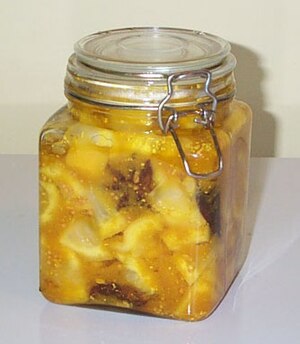
Dry salted lime pickles are produced in Asia and Africa. They are particularly popular in India, Pakistan and North Africa. With dry salting, the limes are treated with dry salt. The salt extracts the juice from the fruit and creates the brine. The final product is a sour lime pickle. Spices are added depending on local preference. In India and Pakistan, the pickle is usually very spicy and hot due to the chilli added. It is usually eaten as a condiment.
Raw material preparation[edit | edit source]
The limes need to be selected and prepared. Only fully ripe limes without bruising or damage should be used. All the limes need to be washed in potable cold water and drained. Each lime is then cut into quarters or four slits made on the skin. All spices should be of good quality and free of mould. Dry salting method is used for pickling many vegetables and fruits including limes, lemons and cucumbers. For dry salt pickling, any variety of common salt is suitable as long as it is pure. Impurities or additives can cause problems:
- Chemicals to reduce caking should not be used as they make the brine cloudy.
- Lime impurities can reduce the acidity of the final product and reduce the shelf life of the product.
- Iron impurities can result in the blackening of the vegetables.
- Magnesium impurities impart a bitter taste.
- Carbonates can result in pickles with a soft texture
Processing[edit | edit source]
The limes are placed in a layer of about 2.5cm depth in the fermenting container (a barrel or keg). One kilogram of salt is added for every four kilograms of limes. The salt is sprinkled over the vegetables. Another layer of vegetables is added and more salt added. This carries on until the container is three quarters full. A cloth is placed above the vegetables and a weight added to compress the vegetables down to assist the formation of a brine. The formation of a brine takes about 24 hours. The container is then placed in the sun for a week. As soon as the brine is formed, fermentation starts. As fermentation starts, bubbles of carbon dioxide appear. Fermentation takes between one and four weeks depending on the ambient temperature. Fermentation is complete when no more bubbles appear.
Flow diagram[edit | edit source]
Selection: only ripe limes should be selected → Wash In clean water → Cut into four pieces or slice the skin → Mix with salt 1kg salt for 4kg of limes → Leave the container in the sun for a week to ferment → Package
Packaging and storage[edit | edit source]
The pickle can now be packaged. The vegetables can be removed from the brine and packaged in a variety of mixtures. These can be vinegar and spices or oil and spices. Lime pickle can be packed in small polythene bags and sealed or in clean jars and capped. Lime pickle keeps well if stored in a cool place. Due to the high acid level of the final product, the risk of food poisoning is low.
References and further reading[edit | edit source]
- Pickled Vegetables (Practical Action Technical Brief)
- Pickled Fruits Practical Action Technical Brief
- Pickled Cabbage (Kimchi) Practical Action Technical Brief
- Pickled Cucumber Practical Action Technical Brief